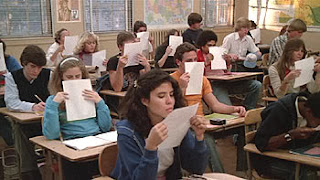Looking for a Handout
 Today I am readying to begin another semester teaching my “Poker in American Film and Culture” class. I’ve changed some of the readings this time around, although we’re sticking with the same sequence of units I employed back in the spring. We’re also going to focus on the same three films -- The Cincinnati Kid, California Split, and Rounders -- this time, too, although I will again show clips from numerous other movies along the way.
Today I am readying to begin another semester teaching my “Poker in American Film and Culture” class. I’ve changed some of the readings this time around, although we’re sticking with the same sequence of units I employed back in the spring. We’re also going to focus on the same three films -- The Cincinnati Kid, California Split, and Rounders -- this time, too, although I will again show clips from numerous other movies along the way.
The first time I taught the course I had intended to have a session early on in which we specifically focused on the rules of various games and how to play. Unfortunately, a snow storm wiped out the first week of classes, and I ended up skipping the tutorial. Later on I wished I hadn’t, since my feeling was not everyone in the class was entirely up on how to play the games we were reading about and watching being played in the films.
This time I’ve again scheduled a day for learning how to play four games in particular -- five-card draw, five-card stud, seven-card stud, and hold’em. I’ve created a handout that briefly sketches how to play each game (along with some other info). The handout is hardly comprehensive, and I’ll probably also be pointing the students to some online sites for further explanation of how to play the games.
I am additionally planning to sit the students in a circle and actually deal each of the games as well. They’ll also be reading three chapters from James McManus’ Cowboys Full in which he goes over the historical backgrounds for draw poker, stud poker, and hold’em, respectively. Should be a fun day, I imagine, but also useful insofar as it might clear up some questions some of those who are less familiar with poker might have later on.
 Anyhow, I thought I’d share the handout with my readers here and solicit any feedback anyone might have. Our “how to play poker” day won’t be coming up until next week, so I have time to revise the handout further if necessary.
Anyhow, I thought I’d share the handout with my readers here and solicit any feedback anyone might have. Our “how to play poker” day won’t be coming up until next week, so I have time to revise the handout further if necessary.
As I say, this is not meant to be a complete outline of all the rules for each variant -- just a general guide for how to play each to be supplemented by our sitting down and playing a few hands of each in class. If you happen to read through it, you’ll see I don’t bring up lowball or Omaha or other types of poker, although I’ll likely mention all of those when we go over the handout in class.
Click on the pic to get to the two-page .pdf. Like I say, any feedback is welcome. Also, everyone please remember that class participation counts towards your final course grade.
Labels: *the rumble, James McManus, Poker in American Film and Culture














4 Comments:
Hey Shamus,
Your stud section seems to miss the forced bring-in. Coupled to the system of antes, that exceeds the per hand risk in the blind games.
I tried to read it but my eyes started to cross. I think the in class demonstration will be essential for anyone who hasn't played. Just the playing sequence will be hard enough for first timers without a whole lot of detail about betting but I would definitely do a demonstration of 'all in' since it figures so prominently in the media.
7-stud is typically played 8-handed, at least these days.
Seldom does every player go to 7th street but if they do then a common card(s) will be dealt.
Ken & Robert... thanks a ton! I've revised that part of the handout. Both of those omissions/mistakes were just me overlooking things/writing the handout too quickly.
AgSweep... I agree, this will probably be the least exciting thing I ask the students to read all semester. I'd never dare hand out something as tedious as this without discussion in class -- or in our case, the demonstration. And good advice about making sure we have an "all-in" bet!
I'm thinking we'll probably deal a hand of each game & have everyone stay in until the end the first hand of each game. Then we'll play a couple more hands of each game in which students can play the hands however they like. There's about 25 in the class, so everybody will get to play something before we're done.
Post a Comment
<< Home